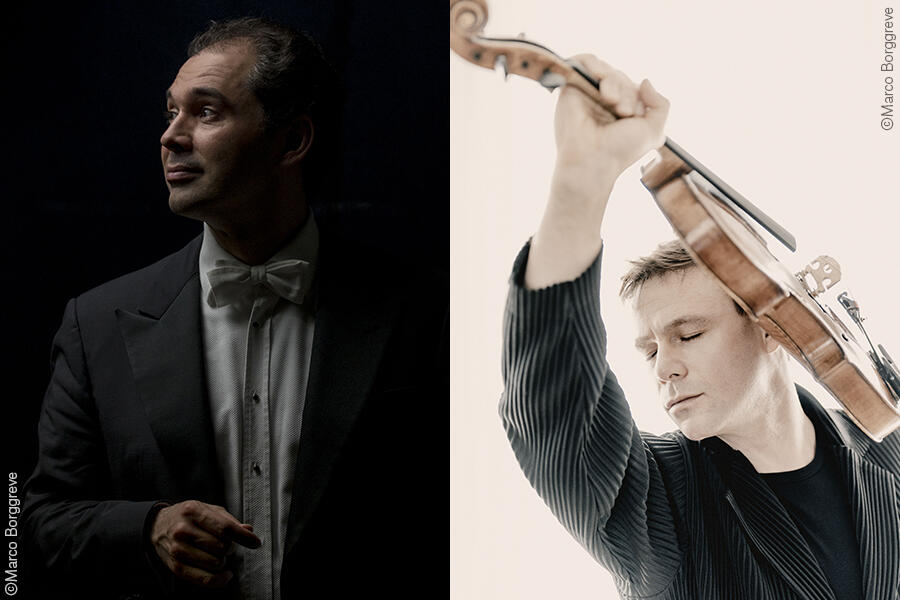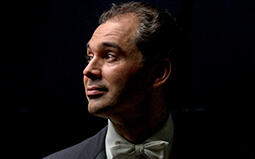- Home
- Concerts
- Subscription Concerts 2022-2023
- Program B
- No. 1976 Subscription (Program B)
No. 1976 Subscription (Program B)

Program
Bartók / Viola Concerto (Serly Version)
Bartók left Europe in 1940 to protest the actions of the Nazis. He, terminally ill and destitute, spent his last years in New York and died there in 1945. The four works (two of which are incomplete) penned during this difficult period are surprisingly amazing and inspiring.
These four include the Viola Concerto of which Bartók left us only the sketches. The solo part was almost finished but the orchestra part was far from completion, therefore his friend Tibor Serly, Hungarian composer and violist, reconstructed the work. This version was premiered in 1949 by the violist William Primrose who initially commissioned Bartók to write the concerto. The opening movement in flexible sonata form starts with the viola's monologue over reserved string beats. This monologue will be recalled near the end of the expressive slow movement. Then the effervescent finale begins without pause. Its virtuosic primary theme is in the Rumanian dance style, and the slower secondary theme has also a folky tint.
[Kumiko Nishi]
Ravel / Daphnis et Chloé, suite Nos. 1 & 2
The Russian impresario Sergei Diaghilev (1872–1929) and his ballet company, Ballets Russes, created a lively sensation in Paris in the early twentieth century. Their big smashes were
Firebird, Petrushka and The Rite of Spring in collaboration with Stravinsky. Ravel was also among the artists involved in Diaghilev’s cutting-edge projects to leave us one of the most
important orchestral repertoires, i. e. the two suites from the ballet
The ballet was premiered in 1912. The scenario, divided in three parts, is an adaptation of an idyllic love story written by the ancient Greek author Longus. It is based on the Greek legend of young Daphnis and Chloe, both brought up on the island of Lesbos. Although the set designed by Léon Bakst for the premiere was influenced by Hellenism, Ravel turned away from any archaic idiom to represent the Greece that "the French painters at the end of the eighteenth century imagined" (his own words).
Suite No. 1 consists of three excerpts from the first and second parts of the ballet. After Pirates abduct Chloe, Nocturne lets Nymphs dance so unconscious Daphnis is revived. Placid Interlude is followed by Danse guerrière (Battle Dance), a barbaric dance of Pirates. Suite No. 2 is almost identical to the third part of the ballet. Lever du jour (Daybreak) depicts the grotto of Nymphs at dawn. Then Chloe, freed, and Daphnis are reunited. At Pantomime, Daphnis
as the god Pan and Chloe as the nymph Syrinx mime. The flowing and elegant flute solo suggests the panpipes (or syrinx), the attribute of Pan. Then the young couple marry. Danse générale (General Dance) is the euphoric denouement of the ballet. Ravel, a.k.a "Magician of Orchestration," meticulously and inventively brings out every instrument's infinite potential to make the ballet sound truly gorgeous and evocative.
[Kumiko Nishi]
Debussy / La mer, three symphonic sketches
By leaving the traditional language in terms of harmony, form and tone color, Debussy had a great influence on music history in the 20th century. La mer (The Sea) is often described as a representative example of Impressionist music, despite his dislike of the label. As a reaction
against excessively emotional music of the late Romantic period, Impressionism in music is characterized by more objective approaches and suggestion of atmosphere or feeling.
A great lover of the ocean, Debussy confessed in a letter, "I was destined for the lovely
career of a sailor, and only a quirk of fate led me to another path." Completed in 1905, La
mer paints a vivid picture of a mighty ocean changing every moment as the subtitle (Three
Symphonic Sketches) hints. Nevertheless, this music rises above descriptive, programmatic music. Indeed, the novelty of the work resides in its rigid but unconventional structure with cyclic themes (mentioned below) and a minute motivic manipulation, which is the reason why it is
often compared to a modern three-movement symphony.
De l'aube à midi sur la mer (From Dawn to Noon on the Sea) has a harmonically ambiguous introduction where two cyclic themes (recurrent elements unifying the whole work) are heard: a sliding-upward motif of two notes repeated by cellos at the beginning, and a fanfare-like wavy melody revealed softly by English horn and trumpet. The main section in D-flat major
becomes animated gradually and reaches its climax with brilliant brass. Jeux de vagues (Play of the Waves) is an intricately constructed yet jolly scherzo, fitful like water in constant change. Dialogue du vent et de la mer (Dialogue of the Wind and the Sea) is a turbulent dialogue of which the main theme, a chromatically rising motif, is introduced by low strings at the start. In addition, this movement recalls the two cyclic themes in different ways with different instrumentation. The triptych ends at a high volume, which is unusual for Debussy, with the magnificent coda animated by the cyclic themes.
[Kumiko Nishi]
Artists
 ConductorTugan Sokhiev
ConductorTugan Sokhiev
Upon the Russian invasion of Ukraine, Tugan Sokhiev voluntarily resigned the position of Music Director of the Orchestre national du Capitole de Toulouse, which he had held since 2008, as well as the position of Music Director and Principal Conductor of the Bolshoi Theater in Moscow, which he assumed in 2014.
He was born in Vladikavkaz in North Ossetia of the former Soviet Union in 1977, and studied conducting under the legendary tutors Ilya Musin and Yuri Temirkanov at the St. Petersburg Conservatory. He garnered the world attention in 1999 when he won the highest prize in the conducting section of the International Proko!ev Competition (no 1st prize was awarded). Through his work at the Mariinsky Theatre, he was also trained by Valery Gergiev. He has been active in both orchestral concerts and operatic works, and has taken a stunning approach when conducting Russian works whilst at the same time having a reputation for conducting French music. With the Deutsche Symphonie-Orchester Berlin for which he served as Music Director and Principal Conductor from 2012 to 2016, he achieved a profound resonance playing German repertoire. Thus he is a conductor with multifarious talents despite being still in his mid-40s.
He first worked with the NHK Symphony Orchestra in October 2008, then !rst conducted its subscription series in November 2013. Since then he has frequently returned to its podium, conducting not only Russian works, but also French, German repertoire and, furthermore, works of Takemitsu. As he has had a good rapport with the orchestra in recent years, the coming collaboration is much anticipated.
[Nobuyasu Matsuoka, music critic]
 ViolaAmihai Grosz
ViolaAmihai Grosz
Born in Jerusalem in 1979, Amihai Grosz started learning violin at the age of five, then switched to viola when he was eleven years old. He studied under David Chen in Jerusalem, then Tabea Zimmermann in Frankfurt and Berlin. Together with his colleagues, he formed the Jerusalem Quartet in 1995, which has performed at major concert halls in the world including the Tonhalle Zürich, Wigmore Hall, London and the Royal Concertgebouw, Amsterdam. The quartet won the Chamber category of the BBC Music Magazine Awards and the ECHO Classic Award for its recordings. He became First Principal Violist with the Berliner Philharmoniker in 2010, and started a new career. In recent years, he has also been keen to perform as a soloist and has worked with
renowned orchestras including the West-Eastern Divan Orchestra under the baton of Daniel Barenboim. This is the first collaboration with the NHK Symphony Orchestra. By his performance
of Bartók’s Viola Concerto, he will fully display the charm of the viola as a solo instrument. He performs on the 1570 'Gasparo da Salò.'
[Yoichi Iio, music journalist]
Download
Ticket
Program B
No. 1976 Subscription (Program B)
Suntory Hall
Google Map
Seating Chart
Single Tickets Release Date
Pre-sales for Subscribers:Thursday, October 27, 2022
*about subscribers
Sale to General Public:Sunday, October 30, 2022
Price
| S | A | B | C | D | |
|---|---|---|---|---|---|
| Ordinary Ticket | 8,900 | 7,400 | 5,800 | 4,700 | 3,700 |
| Youth Ticket | 4,000 | 3,500 | 2,800 | 2,100 | 1,500 |
Seating chart Enlarge Print PDF
*tax included
*About Youth tickets (Available at N-Kyo Guide)
*Subscribers receive a 10% discount (Available at NHKSO WEB Ticket and N-Kyo Guide)
*For wheelchair-accessible seats, please refer to the N-Kyo Guide
Starting Dates of Ticket Sales
ANNUAL SUBSCRIPTION TICKETS Mon., July 18, 2022 11:00am
[For Subscribers: Thu., July 14, 2022 11:00am]
Youth Tickets
Youth Tickets are great options for those of 25 years old and younger
WEB Select 3 Plus
Choose three or more of your favorite concerts and get a discount on single tickets
*Only available at NHKSO WEB Ticket NHKSO WEB Ticket (Accesible from Japan only)
For further information and subscription application
N-Kyo Guide TEL:0570-02-9502


